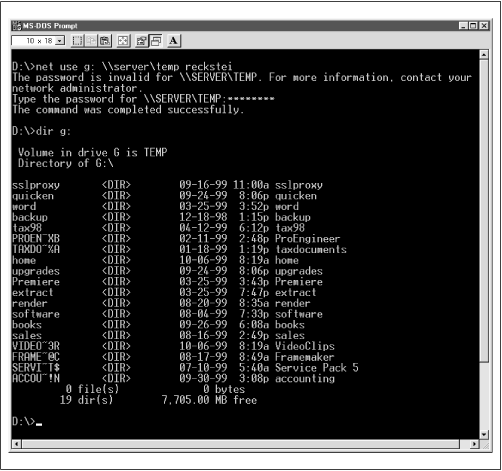| |
Run the command
net
use
*
\
server
\temp on the DOS or Windows client to see if it can connect to the server. You should be prompted for a password, then receive the response "The command was completed successfully," as shown in
Figure 9.2. 
If that succeeded, continue with the steps in the section
Section 9.2.5.5, Testing connections with Windows Explorer." Otherwise:
-
If you get "The specified shared directory cannot be found," or "Cannot locate specified share name," the directory name is either misspelled or not in the
smb.conf file. This message can also warn of a name in mixed case, including spaces, or is longer than eight characters. -
If you get "The computer name specified in the network path cannot be located," or "Cannot locate specified computer," the directory name has been misspelled, the name service has failed, there is a networking problem, or the
hosts
deny
= option includes your host.
-
If it is not a spelling mistake, you need to double back to at least the section
Section 9.2.5.3," to investigate why it doesn't connect. -
If
smbclient does work, it's a name service problem with the client name service, and you need to go forward to the section
Section 9.2.6.2, Testing the server with nmblookup," and see if you can look up both client and server with
nmblookup. -
If you get "The password is invalid for
\
server
\
username," your locally cached copy on the client doesn't match the one on the server. You will be prompted for a replacement.
Windows 95 and 98 clients keep a local
password file, but it's really just a cached copy of the password it sends to Samba and NT servers to authenticate you. That's what is being prompted for here. You can still log on to a Windows machine without a password (but not to NT).
-
If you provide your password, and it still fails, your password is not being matched on the server, you have a
valid
users or
invalid
users list denying you permission, NetBEUI is interfering, or the encrypted password problem described in the next paragraph exists. -
If your client is NT 4.0, NT 3.5 with Patch 3, Windows 95 with Patch 3, Windows 98 or any of these with Internet Explorer 4.0, these default to using Microsoft encryption for passwords (discussed in Chapter 6,
Users, Security, and Domains 's Section 6.4, Passwords in Chapter 6" section, along with the alternatives). In general, if you have installed a major Microsoft product recently, you may have applied an update and turned on encrypted passwords.
Because of Internet Explorer's willingness to honor URLs such as
file://somehost/somefile by making SMB connections, clients up to and including Windows 95 Patch Level 2 would happily send your password, in plaintext, to SMB servers anywhere on the Internet. This was considered a bad idea, and Microsoft quite promptly switched to using only encrypted passwords in the SMB protocol. All subsequent releases of their products have included this correction. Encrypted passwords aren't actually needed unless you're using Internet Explorer 4.0 without a firewall, so it's reasonable to keep using unencrypted passwords on your own networks.
-
If you have a mixed-case password on Unix, the client is probably sending it in all one case. If changing your password to all one case works, this was the problem. Regrettably, all but the oldest clients support uppercase passwords, so Samba will try once with it in uppercase and once in lower case. If you wish to use mixed-case passwords, see the
password
level option in Chapter 6 for a workaround. -
You may have a
valid
users problem, as tested with
smbclient (see
Section 9.2.5.3"). -
You may have the NetBEUI protocol bound to the Microsoft client. This often produces long timeouts and erratic failures, and is known to have caused failures to accept passwords in the past.
The term "bind" is used to mean connecting a piece of software to another in this case. The Microsoft SMB client is "bound to" TCP/IP in the bindings section of the TCP/IP properties panel under the Windows 95/98 Network icon in the Control Panel. TCP/IP in turn is bound to an Ethernet card. This is not the same sense of the word as binding an SMB daemon to a TCP/IP port.
|
|
